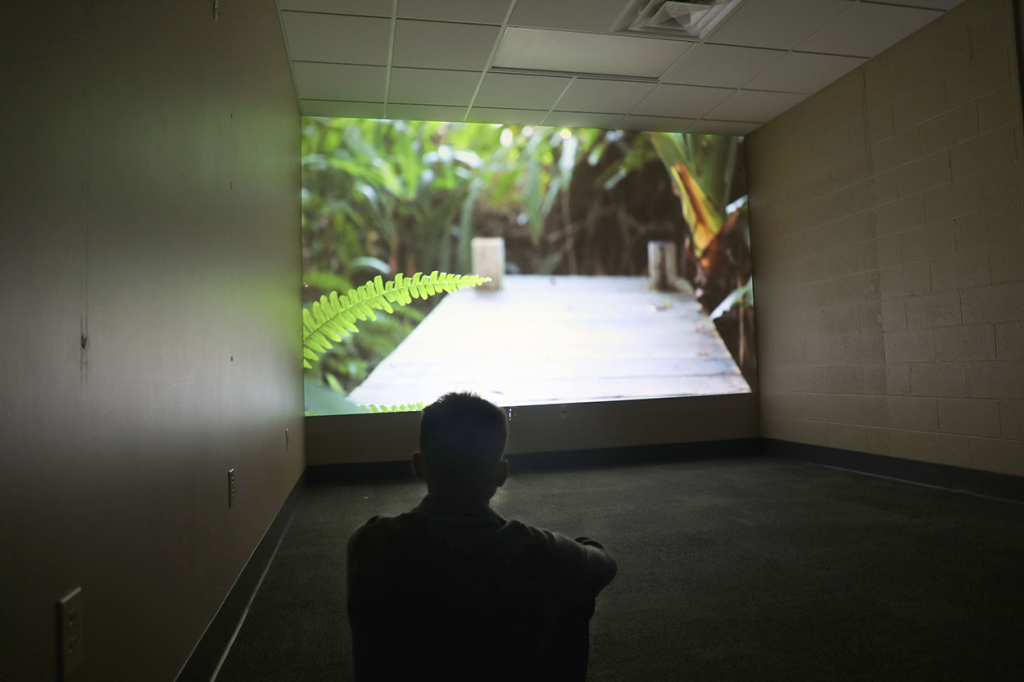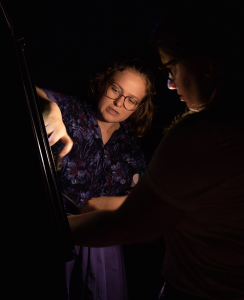
Since 2017, the Art of Death research project has allowed undergraduate students at the University of Missouri to normalize conversations about death and dying through the lens of artistic production. Students use a variety of media tools – such as virtual reality (VR), projection mapping, augmented reality (AR) and video art – to generate creative projects that explore death and dying.
The innovative project is also an interdisciplinary one. Led by Katina Bitsicas, an assistant professor in the MU School of Visual Studies, and Debora Verniz, an assistant professor of architectural studies, students have the opportunity to confront the reality of death through contemporary and historical artistic expression and study how such expressions influence psychological attitudes toward death.

“This project has evolved over the years, but it has always been grounded in the exploration of death and dying,” Bitsicas said. “That’s where my personal research is, and it has been incredibly rewarding to bring students into the project over the years. They’ve jumped in and done such great and inspiring work.”
Art of Death is one of five research projects within the ASH Scholars Program, which includes research teams based in the arts, social sciences and humanities (ASH) disciplines. ASH Scholars receive a $3,000 scholarship, disbursed in four equal parts over the academic year.
The ASH Scholars Program is a collaboration between the Honors College and the MU Office of Undergraduate Research. While the Honors College plays an important role in the program, students do not have to be pursuing the Honors Certificate to participate. Students of all academic majors and grade levels are invited to get involved.
“I’m thankful that Mizzou sees the importance of funding arts-based research and has continued to invest in it,” Bitsicas said. “I know my students see the value of their work – and I know their effort is making a true difference in moving the field forward. The ASH Scholars Program is an incredible one, and I’m happy to play a small role in it.”
Students within the project participate in a variety of hands-on learning experiences. They research other artists and filmmakers whose works are conceptually driven by death and dying. Students also create response projects to their own experiences with death, as well as similar response projects to learned materials and outside studies. Students have plenty of opportunities for data collection, too.
“Our students learn new skills and use digital media tools to produce a group installation exhibition, as well as assist with the data collection for a virtual reality project,” Bitsicas said. “Students also research artworks from the MU Museum of Art and Archaeology collection to draw inspiration from for their own creative projects.”
The project originally featured four faculty collaborators whose interests touched on the subject matter in some way. Bitsicas has been a constant throughout the project, even leading the team by herself last year. She is joined by Verniz this year.
“We’ve shifted a bit depending on which faculty have been involved,” Bitsicas said. “Last year, we moved toward exploring death through new media technologies, an area that is very in line with my own creative research.”
Not only are the students able to interact with new media technologies, but they also share their work with a variety of audiences. For example, students will present at two locations this spring and one next fall – MU’s Research and Creative Achievements Forum; the Digital Graffiti Festival in Alys Beach, Florida; and an exhibition at MU hosted in partnership with the MU Museum of Art and Archaeology.
The team also provides ample opportunities for student mentorship. Several students stay with the program for multiple semesters. That leads to older students taking on leadership roles and guiding younger students.
“There is this definitely an inherent, built-in mentoring quality within the ASH Scholars Program,” Bitsicas said. “It’s incredibly rewarding to see it all come together. I also love that I can work at a deeper level with the students through individual and small group mentoring. The program is amazing in so many ways.”
Bitsicas added that providing research opportunities for students in the arts, social sciences and humanities is vital.
“Researchers in the arts and humanities disciplines have to work very hard to make their research visible,” Bitsicas said. “I work a lot with my students to make sure they can articulate what they’re doing and explain its importance to numerous audiences. We’re tackling important issues of the human experience and doing so in unique ways. We must create these artistic experiences with the viewer in mind to help them better understand the topics we’re discussing.”